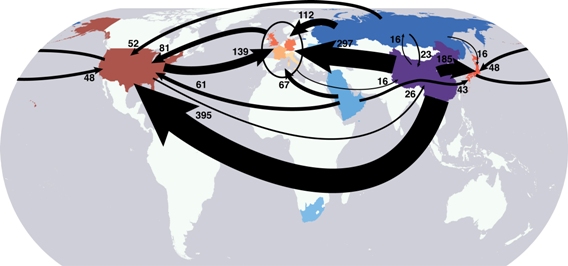Over a third of the carbon emissions related to the consumption of goods in wealthy nations actually occur in developing countries, according to a new analysis by researchers with the Carnegie Institution. Annually, each person if the United States outsources 2.5 tons of carbon due to consumption habits, most frequently in China. In Europe the figure of ‘outsourced’ emissions rises to 4 tons per person.
“Instead of looking at carbon dioxide emissions only in terms of what is released inside our borders, we also looked at the amount of carbon dioxide released during the production of the things that we consume,” co-author Ken Caldeira said in a press release. Caldeira is a researcher in the Carnegie Institution’s Department of Global Ecology.
Using trade data from 2004, researchers created a global model of the movement of products in 57 industries and across 113 countries and regions. Carbon emissions were then calculated as “imported” or “exported” by
acting countries.
“Just like the electricity that you use in your home probably causes CO2 emissions at a coal-burning power plant somewhere else, we found that the products imported by the developed countries of western Europe, Japan, and the United States cause substantial emissions in other countries, especially China,” says lead author Steven Davis of Carnegie Institution. “On the flip side, nearly a quarter of the emissions produced in China are ultimately exported.”
In total the researchers found that the United States outsources 11 percent of its total emissions to developing countries, while Japan outsources nearly 18 percent. European nations outsource even more of their emissions: from 20-50 percent. Some small wealthy nations, such as Switzerland, outsource over half of their total emissions.
“Where CO2 emissions occur doesn’t matter to the climate system,” says Davis. “Effective policy must have global scope. To the extent that constraints on developing countries’ emissions are the major impediment to effective international climate policy, allocating responsibility for some portion of these emissions to final consumers elsewhere may represent an opportunity for compromise.”
The researchers do not make policy recommendations given their analysis, but they write that “it is intuitive that individuals who benefit from a process should bear some responsibility for the associated emissions. Yet, national inventories such as those conducted annually by parties to the United Nations Framework Convention on Climate Change account for only those emissions produced within sovereign territories, ignoring the benefit conveyed to consumers through international trade.”
The study is in the Proceedings of the National Academy of Sciences.
Citation: Steven J. Davis and Ken Caldeira. Consumption-based accounting of CO2 Emissions. PNAS. www.pnas.org/cgi/doi/10.1073/pnas.0906974107.

China is by far the largest “exporter” of carbon dioxide emissions, as seen in this map of the net flow of emissions embodied in trade among the major exporting and importing countries. Arrows indicate direction and magnitude of flow; numbers are megatons (millions of tons). Credit: Steven Davis/Carnegie Institution for Science.
Related articles
Bill Gates: ban coal and invest in clean energy technology
(02/12/2010) The planet needs “energy miracles” to overcome the dual challenges of meeting energy demand and addressing climate change, said Microsoft founder Bill Gates during a speech Friday at the TED Conference in Long Beach, California.
Could special bonds fund the green revolution and stabilize the climate?
(02/02/2010) There is no question that governments around the world are moving slowly and sluggishly to combat climate change, especially when placed against the measures recommended by climate scientists. Only a handful of nations have actually cut overall greenhouse gas emissions, and the past couple decades have seen emissions rise rapidly worldwide as nations like India and China industrialize while Brazil and Indonesia continue massive deforestation. Global temperatures are rising in concert (though with natural fluctuations): the past decade is the warmest on record. After the failure of Copenhagen this past December to produce an ambitious and binding treaty, many are wondering if the world will ever address the threat of climate change or if future generations are set to live in a world far different—and more volatile—than the one we currently enjoy.
Sixty corporations volunteer to measure full lifecycle emissions of products
(01/20/2010) Well-known corporations like Airbus, Levi Strauss & Co., 3M, DuPont, and Kraft Foods are volunteering to ‘road test’ a new global framework to measure the full lifecycle greenhouse gas emission of consumer products from blue jeans to manufactured steel.
Developed countries plan to hide emissions from logging

(12/09/2009) While developing countries in the tropics have received a lot of attention for their deforestation emissions (one thinks of Brazil, Indonesia, and Malaysia), emissions from logging—considered forest cover change—in wealthy northern countries has been largely overlooked by the media. It seems industrialized countries prefer it this way: a new study reveals just how these countries are planning to hide forestry-related emissions, allowing nations such as Canada, Russia, and the EU to contribute to climate change without penalty.

(12/07/2009) Two of the world’s most serious issues—poverty and climate change—are interconnected. With a rise in one’s income there usually comes a rise in one’s carbon footprint, thereby threatening the environment. Wealthy nations have the highest per capita carbon footprints, while developing nations like India and China—which are experiencing unprecedented economic growth—are becoming massive contributors of greenhouse gases. However, it is those who have the smallest carbon footprint—the world’s poor—who currently suffer most from climate change. Food crises, water shortages, extreme weather, and rising sea levels have all hit the poor the hardest.
Americans throw away enough food every year to feed 200 million adults
(11/30/2009) The amount of food Americans throw away has risen by approximately 50 percent since 1974 according to a new study in PLoS ONE. American now waste on average 1400 calories per person everyday, equaling 150 trillion calories a year nationwide. Considering that the average person requires approximately 2,000 calories a day, this means that the US could feed over 200 million adults every year with the food that ends up in the trash. Currently, the UN estimates that one billion people—an historical record—are going hungry worldwide.